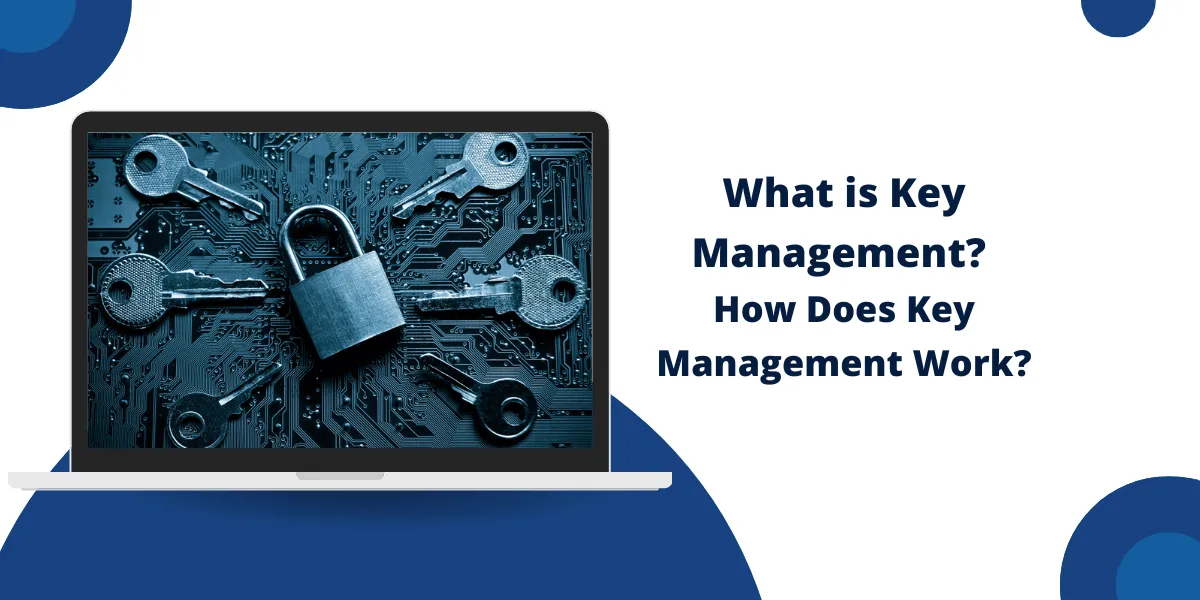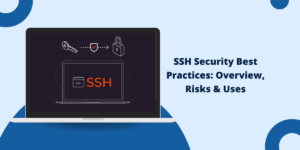What is Key Management?
Key management refers to the processes, policies, and procedures that an organization implements to protect, generate, store, backup, retrieve, and destroy cryptographic keys. It is a critical component of cryptosystems as it determines how keys are handled throughout their lifecycle. Proper key management is essential for maintaining the confidentiality, integrity, and availability of encrypted data and systems.
Key Takeaways
- Key management involves the full lifecycle of cryptographic keys, including generation, distribution, storage, use, revocation, expiration, and destruction.
- It aims to protect keys against unauthorized access, disclosure, modification, or destruction through policies, procedures, roles, and responsibilities.
- Key management helps ensure keys are available when needed to decrypt and access data but secured against theft and misuse at other times.
- Best practices include using secure key generation and storage, key backups, key rotation, access controls, auditing, and documentation.
- Hardware Security Modules (HSMs) provide secured cryptographic key generation, storage, and operations to strengthen key protection.
- Standards like NIST SP 800-57 Part 1 provide guidelines for proper cryptographic key management.
How Does Key Management Work?
Key management involves managing the full lifecycle of cryptographic keys. Here are the main phases and activities involved:
Key Generation
- Keys are generated using industry-standard algorithms like AES, RSA, and ECC based on cryptographic best practices.
- Randomness and entropy are critical for generating strong keys that are hard to predict. Hardware random number generators or cryptographic pseudorandom number generators are used.
- Parameter selection is also important for generating keys of the desired strength. For example, longer key sizes make brute force attacks harder.
Key Distribution
- Secure channels are used to distribute keys to authorized entities and prevent interception. Common methods include asymmetric encryption, TLS connections, and physical transfer of storage media.
- Key wrapping encrypts keys using other keys for secure distribution and storage.
- In public key systems, certificate authorities help establish trust between entities when distributing public keys.
Key Storage
- Keys must be stored securely when not in use through access controls, encryption, hardware security modules (HSMs), backups, and redundancy.
- Key storage locations include secure databases, HSMs, smart cards, and encrypted files. The location depends on the frequency of use, required availability, and security needs.
- Backups allow recovery if keys are lost or damaged. Backups must be protected equivalently to live keys.
Key Usage
- Cryptographic operations are performed with authorized keys to encrypt or decrypt data, generate digital signatures, verify identities, etc.
- Keys should only be unencrypted when loaded into trusted cryptographic modules that use them.
- Access controls limit key usage to authorized persons, applications, and processes. This prevents misuse.
- Keys must be retained in memory only as long as required. They should be wiped after use.
Key Changes
- Key rotation or revocation disables old keys and transitions to new ones. This limits the amount of data exposed if a key is compromised.
- Cryptoperiods determine when keys should expire and be replaced. This mitigates risk over time as keys weaken due to advances in cryptanalysis.
- Key changes require the secure propagation of new keys and migration of encrypted data to the new keys.
Key Destruction
- Keys no longer needed must be destroyed securely when retired or replaced to prevent subsequent misuse.
- Secure key destruction techniques include cryptographic erasure, physical destruction of key storage media, and degaussing.
- All archived or backed-up copies of the keys must also be destroyed.
Why is Key Management Important?
Proper key management is crucial for maintaining the security of encrypted data. Here are some key reasons why organizations invest in lifecycle-based key management:
- Prevents unauthorized access: Controls access to keys to prevent theft and misuse that could compromise confidential data.
- Maintains availability: Enables access to encrypted data by ensuring authorized users have working keys when needed.
- Reduces risk: Key changes and expiration lower the potential impact of compromised keys, and backup protects against lost keys.
- Retains control: The organization owns and manages keys centrally through policies. Individual employees do not control keys.
- Meets compliance: Regulations like HIPAA, PCI DSS, and NIST require key management. Documented processes help demonstrate due care.
- Enables monitoring: Auditing tracks all key state changes. Unauthorized activity can be detected.
- Standardizes practices: Establishes consistent, repeatable key management lifecycle procedures across the organization.
Key Management Best Practices
To help organizations implement robust key management, standards like NIST SP 800-57 Part 1 provides guidelines for cryptographic key lifecycle management based on industry best practices. Here are some high-level best practices:
Use Strong Keys
- Generate keys using current cryptographic standards and proper random number generation.
- Select appropriate algorithms and key lengths to protect against brute-force attacks.
- Ensure private and symmetric keys have enough randomness and entropy to make them unpredictable.
Secure Keys
- Only store and transmit keys in encrypted form.
- Use hardware security modules (HSMs) to generate, store, and handle keys.
- Enforce access controls through separation of duties, least privilege, and authorizations.
- Detect unauthorized changes by enabling cryptographic tamper evidence.
Limit Access
- Only allow key use through authorized systems and processes.
- Encrypt keys and segregate duties across generation, storage, backup, and usage.
- Destroy keys securely when no longer needed.
Change Keys Periodically
- Rotate keys to limit exposure over time.
- Revoke compromised keys immediately.
- Set cryptoperiods to force proactive key replacement.
Backup Keys
- Maintain encrypted backups of keys for disaster recovery.
- Store key backups separately from operational keys.
- Backup HSMs provide redundancy and availability in case of failure.
Log Key State Changes
- Audit all key management operations.
- Monitor for unauthorized key usage.
- Log events like key generation, rollout, revocation, and destruction.
Key Management Responsibilities
Effective key management requires clear roles and responsibilities established through policy.
Typical key responsibilities include:
- Key Manager: oversees the key management process and lifecycle for an organization.
- System Administrators: responsible for implementing the technical infrastructure, including HSMs, key storage, and backup systems.
- Security Officer: establishes key management policies, reviews processes, and monitors compliance.
- Key Custodians: trusted individuals that securely handle and track cryptographic keys.
- End Users: use keys to encrypt or decrypt data through authorized systems.
- Auditors: periodically review key management practices for compliance with policy and standards.
- Executive Management: maintains oversight of the key management program.
What are the Components of Key Management System
A comprehensive key management system requires technical controls and infrastructure to protect keys across their lifecycle. Common components include:
Hardware Security Modules (HSMs)
HSMs are tamper-resistant, physical computing devices that provide secure key generation, storage, operations, and protection. They also prevent keys from being exported in plaintext.
Key Management Servers/Appliances
These provide centralized policy-based key generation, issuance, storage, lifecycle management, and auditing capabilities.
Backup Systems
Provide redundant key storage and disaster recovery capabilities in case of failure or data loss.
Cryptographic Modules
Trusted software or hardware modules that perform approved cryptographic algorithms to encrypt, decrypt, and digitally sign using keys.
Key Storage Repositories
Databases, directories, and vaults securely store keys and metadata such as ownership, access policies, and usage logging.
Access Controls
Authentication, authorization, and accounting controls that restrict key usage to authorized persons or processes.
Best Practices of Key Management Standards
Several standards provide guidance and best practice recommendations for implementing robust key management:
- NIST SP 800-57: Comprehensive guidance for cryptographic key management from the National Institute of Standards and Technology (NIST).
- ISO 11568: International standard for key management practices, including generation, registration, certification, revocation, and destruction.
- ANSI X9 standards: Standards for cryptographic algorithms and key management published by the American National Standards Institute (ANSI).
- FIPS 140-3: U.S. government computer security standard that approves cryptographic modules for protecting keys.
- PCI DSS: The Payment Card Industry Data Security Standard (PCI DSS) requires proper key management to encrypt cardholder data.
- CIS Key Management Controls: The Center for Internet Security (CIS) publishes security best practices for effective key management and cryptographic protection.
- Symmetric Key Management: For symmetric encryption, NIST SP 800-57 Part 1 recommends using a master key to generate data encryption keys for operational use. The master key is securely stored and backed up, while data keys are rotated frequently.
- Public Key Management: Digital certificates issued by trusted certificate authorities help establish authenticity when distributing public keys for use in public key cryptography.
- Hybrid Key Management: For greater security, hybrid cryptosystems use a combination of symmetric and asymmetric keys. The symmetric keys provide efficient encryption, while public keys help securely exchange the symmetric keys.
- Key Metadata: Metadata like crypto periods, usage limits, ownership, access policies, and audit logs should be stored with keys in the management system. This enables policies to be enforced.
- Key Recovery: The ability to recover lost encrypted data relies on the availability of key backups. Organizations should maintain multiple backups that are stored securely in separate locations.
Key Management Plan
A comprehensive written key management plan helps organizations implement effective lifecycle-based key management. The plan should cover:
- Roles and responsibilities for managing keys
- Approved key generation standards and algorithms
- Secure backup, redundancy, and availability requirements.
- Key storage mechanisms and controls
- Key distribution and transmission methods
- Access control and authorization policies
- Key rotation frequency and crypto periods
- Key revocation and replacement procedures
- Key destruction and disposal methods when retired
- Key inventory tracking and auditing procedures
- Disaster recovery protections
Key Management Process Flow
The full lifecycle for cryptographic keys generally involves the following steps:
- Key Generation: Generate new keys using approved cryptographic modules and parameters. Generate in HSM for better protection.
- Key Distribution: Securely distribute keys to authorized entities that will use them, leveraging asymmetric encryption and certificates if distributing public keys.
- Key Storage: Store keys securely using encryption, access controls, and HSMs. Enable key backup and redundancy.
- Key Use: Load keys into trusted cryptographic modules and cryptographically process data (e.g., encrypt, decrypt, sign) as authorized.
- Key Change: Replace keys with new ones through rotation, revocation, or expiration to limit lifetime as per policy.
- Key Backup: Back up keys in their encrypted state and store the backups separately from operational keys.
- Key Destruction: Destroy keys completely when expired or no longer needed. Destroy all archived, cached, and backed-up copies.
- Key Auditing: Log and audit all key state changes, access, and usage. Monitor for policy violations.
Final Words
Effective key management is essential for realizing the full benefits of cryptography in securing sensitive data. By protecting keys against unauthorized access and managing them across their entire lifecycle, organizations can maintain control over encrypted data. Robust practices for key generation, distribution, storage, usage, rotation, and destruction are crucial.
Standards like NIST SP 800-57 provide excellent guidance for implementing systematic key management programs with assigned roles and responsibilities. With proper key management, organizations can securely unlock the power of cryptographic controls and minimize risks to their most vital information assets.
Frequently Asked Questions About Key Management
Here are some common questions and answers about cryptographic key management:
How often should cryptographic keys be rotated?
Industry recommendations for key rotation vary by algorithm and use case. For Public Key Infrastructure (PKI), certificates are often valid 1-3 years. Symmetric data encryption keys may be rotated every 3-12 months. Master keys are rotated less frequently.
How can lost encryption keys be recovered?
The only way to recover lost keys is via encrypted backups stored separately from operational keys. Organizations should maintain multiple redundant backups to allow the restoration of lost keys.
What is perfect forward secrecy, and why is it important?
Perfect forward secrecy uses ephemeral session keys so that a compromise of one key cannot decrypt past communication sessions. This limits data exposure if long-term keys are compromised.
How are cryptographic keys securely destroyed?
Keys should be destroyed by cryptographic erasure, such as overwriting with zeros, degaussing physical media, or physical destruction of media. All backups must also be destroyed.
What are hardware security modules (HSMs), and why are they used?
HSMs are dedicated hardware devices that provide secure generation, storage, and usage of keys inside tamper-resistant physical modules. HSMs prevent plaintext keys from being exported.
How does encryption key management differ between symmetric and public key cryptography?
Symmetric keys must be transmitted securely, while public keys can be openly distributed as public-private key pairs. Public keys use PKI and certificates for identity and authentication.
What standards exist for best practices in encryption key management?
Key standards include NIST SP 800-57, ISO 11568, ANSI X9, and PCI DSS requirements. These provide guidelines for proper lifecycle-based management of cryptographic keys.
What safeguards prevent unauthorized access to encrypted keys?
Access controls, separation of duties, the principle of least privilege, key encryption, HSMs, and disabling interfaces prevent unauthorized users or processes from accessing keys.

Priya Mervana
 Verified Web Security Experts
Verified Web Security Experts
Priya Mervana is working at SSLInsights.com as a web security expert with over 10 years of experience writing about encryption, SSL certificates, and online privacy. She aims to make complex security topics easily understandable for everyday internet users.



